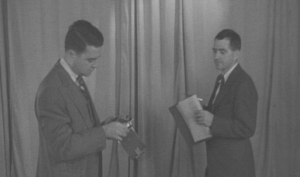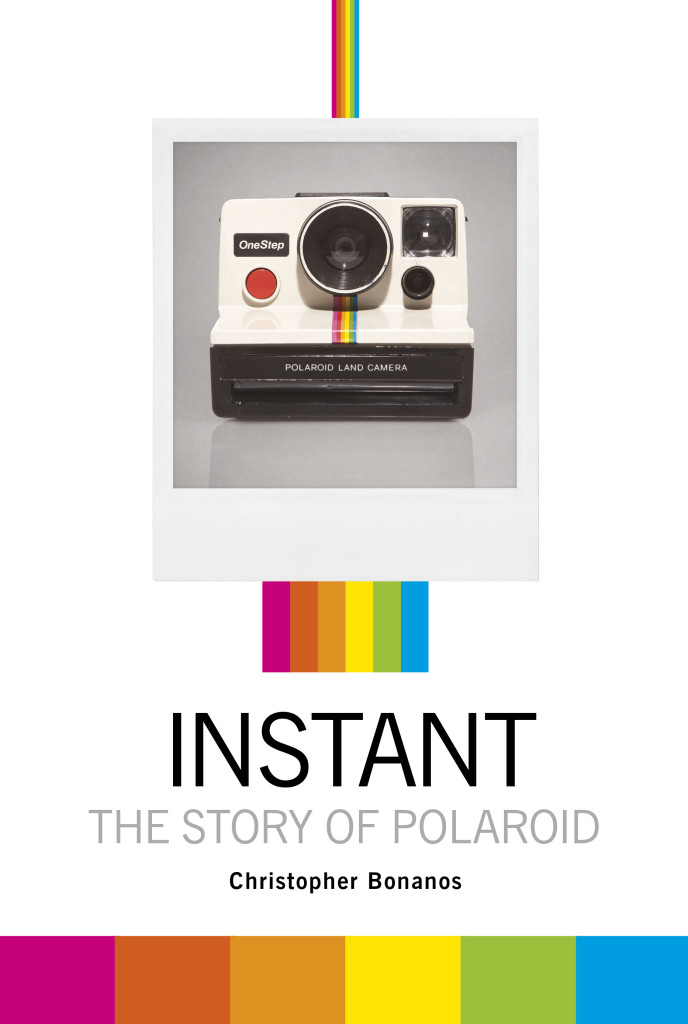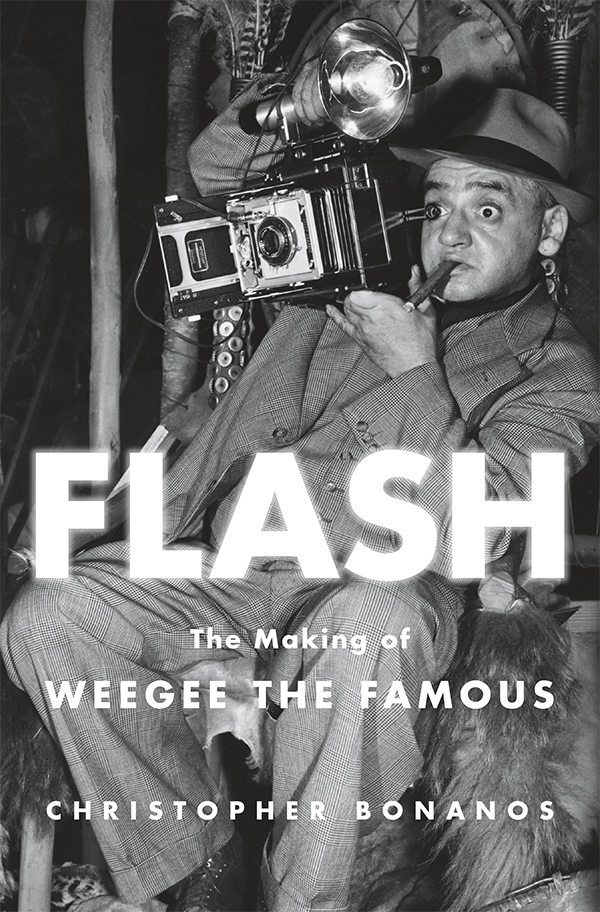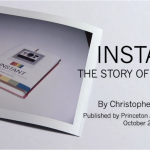
Weegee at work, December 9, 1939. Unidentified photographer. Courtesy of the International Center of Photography.
I won’t be moving on from delivering Polaroid news anytime soon, but I’m happy to announce that the proposal for my next book has sold. It’ll be a biography of Weegee, a.k.a. Arthur Fellig, the greatest crime photographer ever to walk New York’s streets. Henry Holt will publish, and (based on my manuscript due date) the book is likely to appear in early 2017. Like INSTANT, it lies at a place where several of my interests—New York City, photography, newspapers, journalism as art—intersect. It’s an intimidating thing to sign a book contract, but I’m excited about it.
The owners of the old British newsreel company Pathé have thrown open the archive, offering free previews of tens of thousands of their films. You k now what I searched for first, and I was not disappointed. Here’s a clip from 1948: Dr. Land shows off the Model 95 camera.
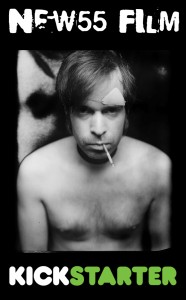 Breaking news in Polaroidland, and this is actually pretty big.
Breaking news in Polaroidland, and this is actually pretty big.
I’ve posted before about the wonders of Type 55, the 4-by-5-inch peel-apart film that gave photographers both a print and a usable negative. It was black-and-white, and slow in speed–the negative was ISO 25 to 35, the print ISO 50–so its images were extremely fine-grained. It was last produced, along with Polaroid’s other film lines, in 2009. Any Type 55 that’s left is long expired and entering its final stage of questionable reliability. Soon the stock of this product—for which many photographers had a deep and longstanding affection—will be exhausted forever.
Since 2011, an entrepreneur in Massachusetts named Bob Crowley has cultivated a plan to produce a new positive/negative instant film. After experiments with single-reagant processing tanks and other methods, he and a small team have worked out a product they call New55, based on an available negative and their own positive sheet. It’s a complex thing to make, but they’ve figured out how to do it, and their prototype photographs look good (that’s one by Tobias Feltus in the Kickstarter banner at right). They have also improved one detail about old Type 55: this new product’s positive and negative will have the same ISO rating, so you won’t have to choose which half is over- or underexposed.
The startup costs of New55 are considerable, and Crowley and an investor have been footing the bill for R&D. Now it is time for New55 to test the market, to see whether this is a viable product. The Kickstarter campaign will begin this Monday, and you heard it here first. It’s a tall order—they’re looking to raise an amount in the mid-six figures. But I also know that there are still many, many people who used and loved Type 55, and did not want to see it go away.
I suspect Bob and his team are going to feel that love this month, and I myself will be signing on with a preorder. I hope you will do the same. This is, I think it’s safe to say, the very last chance photographers will ever have to obtain a new peel-apart black-and-white instant film. (Fuji’s final run of FP-3000B is due in the U.S. this very month, and it’s never coming back.) If this plan works, and the audience and the market prove sustainable, an extraordinary visual medium will have been yanked back from the edge of oblivion.
The sticking point may be price: This product is made at very small scale, and will be a lot more expensive than Type 55 was. On Monday we’ll see exactly how much, but I have heard $10 to $12 per sheet batted around. It sounds like a bracing number; then again, shooting a sheet of 4×5 Tri-X and having it processed, at least in my neighborhood, is now in the $6 range, and takes a couple of days.
Until the actual Kickstarter campaign goes up, click here to get the latest news. When the actual campaign goes live, I’ll add a link.
UPDATE, 3/22/2014: Kickstarter campaign is live, and here’s the link. You are encouraged to go click and donate.
The New York Times has posted an obituary for Mitch Leigh, composer of Man of La Mancha. A sweet man, by all accounts, who enjoyed his work in the advertising-jingle world plenty, and then had one immense shining Broadway hit that will endure as long as Broadway shows are around. “The Impossible Dream” is still a show-stopper every time.
Of course, we here at Polaroidland know him for a somewhat briefer masterpiece. Specifically, the best TV commercial of its era:
Most of the old DDB players are gone now. Phyllis Robinson, who wrote the words to Leigh’s insanely catchy music, died on the last day of 2010. Here’s something extremely nice that my colleague Kera Bolonik wrote about her then.
There seems to be no end to the parade of Polaroid kitsch out there, and these two products in particular make me laugh every time.
This one slices cheese.
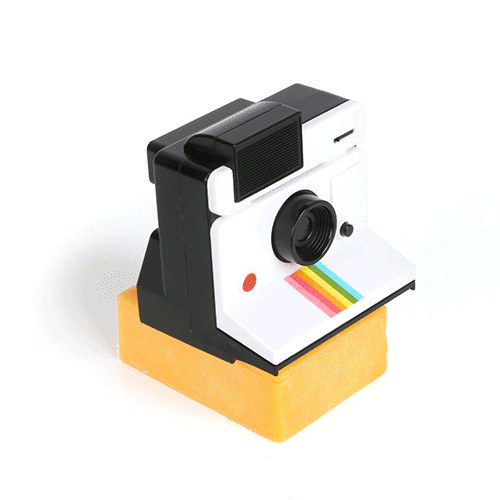
And this one is for… well, let’s just say after you eat the cheese.
 I have a very tolerant spouse, but when I showed her the toilet-paper one, she delicately said, “Not everything in our life has to be Polaroid.” Gotta admit, she’s probably right about this one.
I have a very tolerant spouse, but when I showed her the toilet-paper one, she delicately said, “Not everything in our life has to be Polaroid.” Gotta admit, she’s probably right about this one.
Does the logo for Nationwide Insurance remind you of anything?
When this logo was launched in in 1999, the Website Business First described it thus: “The focus of the brand campaign will be an unusual new logo … a picture frame with the word ‘Nationwide’ on the bottom. Nationwide says the frame will be a ‘living logo’ that can feature customer images or anything else the company wants to highlight.” I wonder whether Polaroid—admittedly, in pretty bad shape by then, but still a billion-dollar company with a sizable team of lawyers and an interest in its own trade dress—had anything to say about it.
LEGALITIES
This site is not connected with or endorsed by Polaroid or PLR IP Holdings, owners of the Polaroid trademark.ON TWITTER
My TweetsBlogroll
- 'Insisting on the Impossible'
- Everything Reminds Me of You
- Flickr's Polaroid group
- Instant Options
- LandCameras.com
- Paul Giambarba: Analog Photography At Its Best
- Paul Giambarba: The Branding of Polaroid
- Polaroid
- Polaroid SF
- Rare Medium
- The Impossible Project
- The Land List
- The New55 Project
- Vintage Instant

